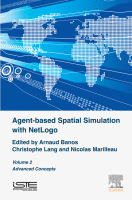Browse content
Table of contents
Actions for selected chapters
- Full text access
- Book chapterAbstract only
1 - NetLogo, an Open Simulation Environment
Benoit Gaudou, Christophe Lang, ... Jean-Marc Nicod
Pages 1-36 - Book chapterAbstract only
2 - Multiscale Modeling: Application to Traffic Flow
Arnaud Banos, Nathalie Corson, ... Patrick Taillandier
Pages 37-62 - Book chapterAbstract only
3 - Macro Models, Micro Models and Network-based Coupling
Arnaud Banos, Nathalie Corson, ... Sébastien Rey Coyrehourcq
Pages 63-84 - Book chapterAbstract only
4 - Networking, Networks and Dynamic Graphs
Stefan Balev, Antoine Dutot and Damien Olivier
Pages 85-116 - Book chapterAbstract only
5 - Swarm Problem-Solving
Antoine Dutot and Damien Olivier
Pages 117-172 - Book chapterAbstract only
6 - Exploring Complex Models in NetLogo
Philippe Caillou, Sébastien Rey Coyrehourq, ... Arnaud Banos
Pages 173-208 - Book chapterNo access
Conclusion
Arnaud Banos, Christophe Lang and Nicolas Marilleau
Page 209 - Book chapterNo access
Bibliography
Pages 211-218 - Book chapterNo access
List of Authors
Stefan Balev, Arnaud Banos, ... Patrick Taillandier
Pages 219-220 - Book chapterNo access
Index
Pages 221-222
About the book
Description
Whereas Volume 1 introduced the NetLogo platform as a means of prototyping simple models, this second volume focuses on the advanced use of NetLogo to connect both data and theories, making it ideal for the majority of scientific communities.
The authors focus on agent-based modeling of spatialized phenomena with a methodological and practical orientation, demonstrating how advanced agent-based spatial simulation methods and technics can be implemented.
This book provides theoretical and conceptual backgrounds, as well as algorithmic and technical insights, including code and applets, so that readers can test and re-use most of its content.
Whereas Volume 1 introduced the NetLogo platform as a means of prototyping simple models, this second volume focuses on the advanced use of NetLogo to connect both data and theories, making it ideal for the majority of scientific communities.
The authors focus on agent-based modeling of spatialized phenomena with a methodological and practical orientation, demonstrating how advanced agent-based spatial simulation methods and technics can be implemented.
This book provides theoretical and conceptual backgrounds, as well as algorithmic and technical insights, including code and applets, so that readers can test and re-use most of its content.
Key Features
- Illustrates advanced concepts and methods in agent-based spatial simulation
- Features practical examples developed, and commented on, in a unique platform
- Provides theoretical and conceptual backgrounds, as well as algorithmic and technical insights, including code and applets, so that readers can test and re-use most of its content
- Illustrates advanced concepts and methods in agent-based spatial simulation
- Features practical examples developed, and commented on, in a unique platform
- Provides theoretical and conceptual backgrounds, as well as algorithmic and technical insights, including code and applets, so that readers can test and re-use most of its content
Details
ISBN
978-1-78548-157-4
Language
English
Published
2017
Copyright
Copyright © 2017 Elsevier Ltd. All rights reserved.
Imprint
ISTE Press - Elsevier
